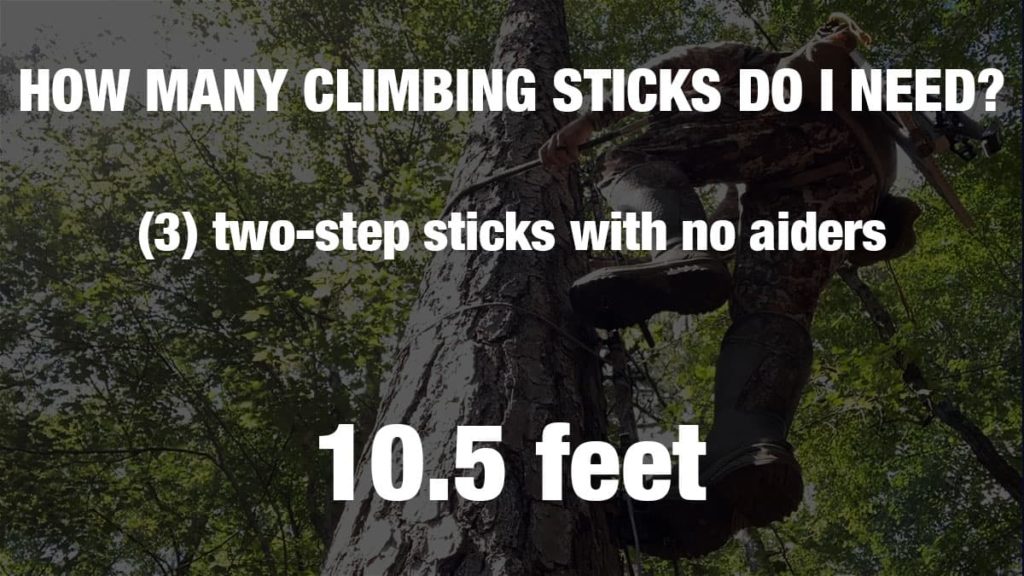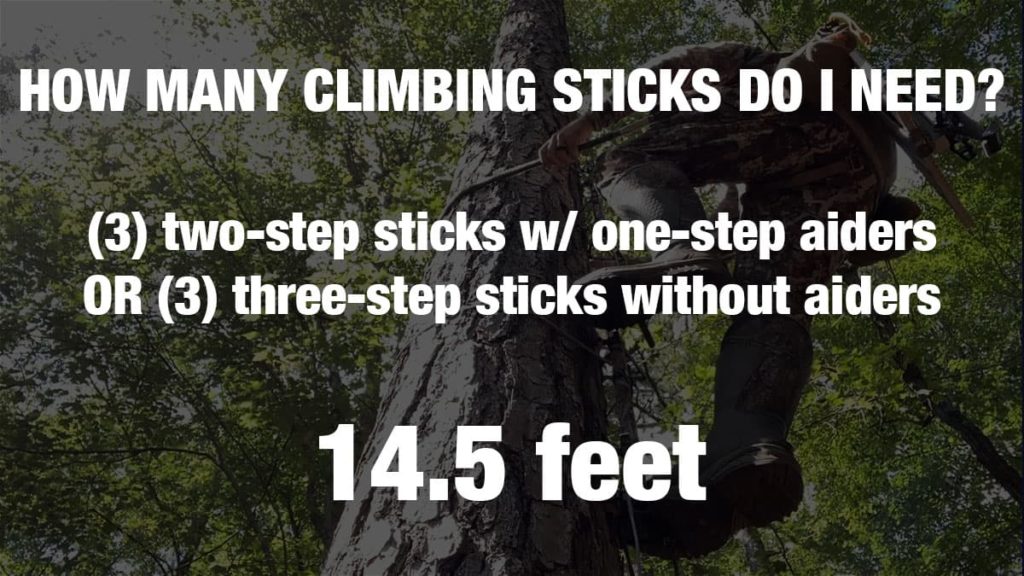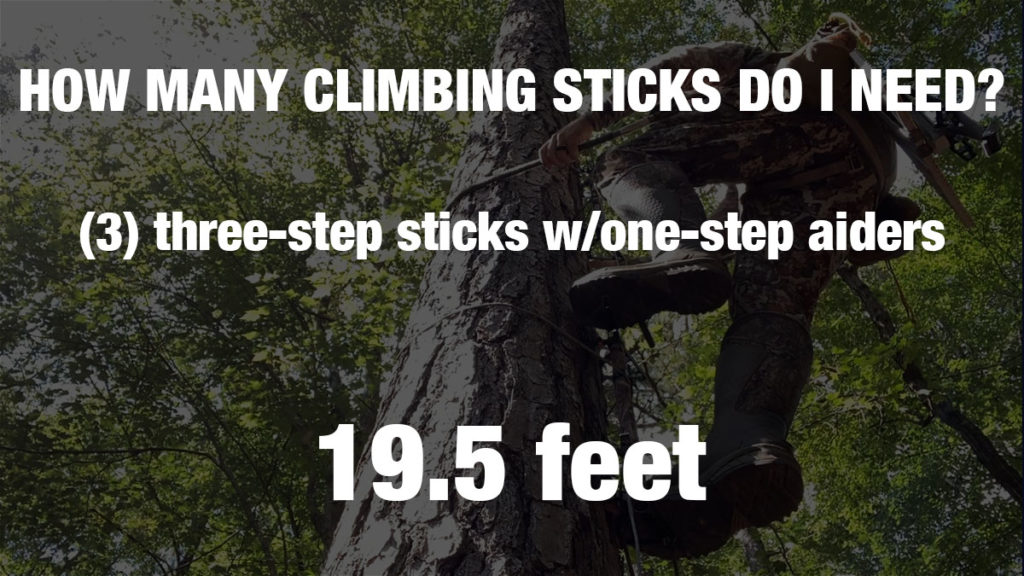How Many Climbing Sticks Do I Need for Saddle Hunting?
JUMP TO: What are Aiders? | Our Test Method | How High Could We Get? | How High Should You Deer Hunt?
When it comes to saddle hunting, one of the most common questions I hear is, “How many climbing sticks do I need?” The answer to this question depends on a few factors, most importantly of which is how high you want to get in the tree.
In this article, we’ll answer that question definitively to help you decide what type of climbing sticks you need, how many you need, and whether or not you’ll need aiders to help you reach your desired hunting height.
What are Aiders?
If you’re brand new to saddle hunting and climbing sticks, then you’ll need to know about aiders. If you’re already familiar with them, feel free to skip down to the next section.
Aiders are additional steps for your climbing sticks made of lightweight rope, nylon, or cable. They resemble a rope ladder, and can add anywhere from one to four or more additional steps to your sticks.
While aiders are a great way to get additional height out of your climbing sticks, they also can increase your risk of a potential fall or mishap.
Due to their flimsy nature, it can be easy to miss an aider with your foot, or not get your foot in there good enough to hold your weight. They can also kick out from the tree if your weight isn’t perfectly balanced in the middle of the step, causing you to fall.
Our Test Method
To answer the question of how many climbing sticks you need, I ran a test with two- and three-step sticks, with and without aiders. For each test, I placed the bottom step approximately 18 inches off the ground, spaced the sticks 18 inches apart, and hung the platform approximately 18 inches above the top step.
My two-step sticks are 18” long, and my three-step sticks are around 36 inches long, which is why I made the spacing above the ground and between the sticks 18 inches. That accommodates an average height hunter being able to comfortably climb from step to step without having to overstretch.
Obviously a taller person could increase that spacing to get a little higher, and a short person may need to reduce that spacing a bit to climb comfortably. So your actual results may vary some from mine, but this is more about just giving you a good baseline for what equipment you need to start saddle hunting.
How High Could We Get?
Initial Test: (3) Two-Step Climbing Sticks
For my initial test, I used (3) two-step climbing sticks without aiders. By spacing them 18 inches apart and starting the first stick 18 inches off the ground, I was able to set my platform right at 10.5 feet.

That’s not as high as most saddle hunters like to get, but it may be high enough for many setups. We’ll dive more into how high you need to get in the tree in a separate section below.
My next test involved the same three sticks, but this time I used one-step aiders on each stick. That essentially made them three-step sticks. Again, we made the first step (bottom aider) 18 inches off the ground, separated the sticks with aiders 18 inches apart, and set the platform 18 inches above the top step.
This time we were able to get the platform 14.5 feet high. That’s getting closer to the 15-20 feet that seems to be many saddle hunters’ sweet spot.

Next Test: (3) Three-Step Climbing Sticks
Next I put my three-step sticks to the test. There was no need to run a test with just the steps without aiders, because that’s exactly the same setup as the two-step sticks with single-step aiders.
So if you use (3) three-step climbing sticks without aiders, you can expect to get around 14.5 feet high at platform level.
My last test was the (3) three-step climbing sticks with one-step aiders on each. Spaced the same as the previous tests, you should be able to get your platform about 19.5 feet off the ground. That’s getting high enough to handle most any saddle hunting situation.

Other Aider Options
For those who want to climb higher, adding another stick or using three-step climbing sticks with multi-step aiders would be necessary. However, I recommend not going above a one-step aider on the second, third, or fourth sticks for safety reasons. You’re better off adding an extra stick rather than risking a fall and injury.
How High Should You Deer Hunt?
This is another common question among new saddle hunters, as well as treestand hunters. And the answer is a disappointing, “It depends.” There are a few considerations before determining this answer for yourself:
- How high are you comfortable climbing?
- How many climbing sticks can you afford to buy?
- How high is the surrounding cover?
No matter what equipment you have or how serious you are about killing a deer, never climb higher than you’re comfortable hunting from. Not only does that take all the fun out of hunting if you’re fearful the whole time you’re in the tree, but it also creates an unsafe situation. There are plenty of methods to shoot deer without having to climb to an uncomfortable height.
The next question you have to consider is your budget for climbing sticks. You may be comfortable 25 foot in the tree, but if you can only buy (3) two-step sticks right now, you’re not going to be able to hunt that high. And that’s okay, because you don’t have to. You just need to hunt as high as the cover, and that’s our third consideration.
I hunt with (3) two-step sticks with one-step aiders on each. So I can get around 15 feet high. And I rarely feel like I need to be any higher than that. In fact, there’s been multiple times I had to leave a stick laying on the ground because I only needed two.
That’s because I intentionally seek out trees with decent cover closer to the ground — at maybe 8 to 10 feet. That cover can be branches in the tree you’re climbing or cover from an adjacent tree or shrub. I’ll choose being 10 feet high with good cover over 20 feet high with no cover every time.

But what defines “good cover”? Can you provide visually what 10 feet off the ground with good cover looks like..
I’m new to saddle hunting just now learning about it. I’m short so apart from a ladder stands and without using aiders, 10.5 feet will be my sweet spot.. I’m going to assume good cover would be anything that would break up your pattern? So I would most likely use those tree branch holders where you can stick branches in them to give cover it it would be highly adaptive to where I’m expecting the deer to move as how a ladder stand would work..
or get onto the one stick system with rappelling, as high as you need to to be gain cover, negating need for multiple aticks.